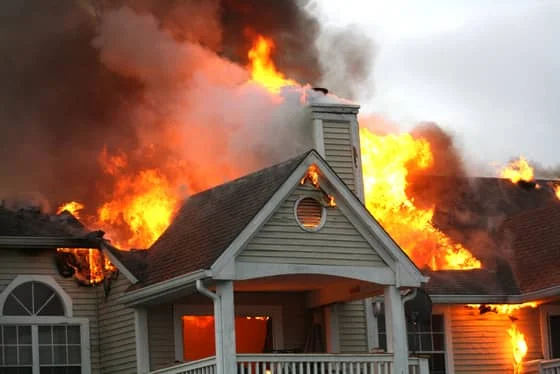If your property has been severely damaged by fire and you’re considering selling a fire-damaged house, you may need to rent a storage unit for any undamaged items
For example, if you need to stay in a smaller rental home or apartment, you may need the storage unit to store furnishings and other items that won’t fit in your new living accommodations.

Here are some things to consider when renting a storage unit after a house fire to ensure you get maximum value for your money.
One of the first things you will need to consider is what size storage unit you need to store your belongings. This step is crucial in the aftermath of a house fire, as it helps you determine the appropriate space required to safeguard your recoverable items during the restoration process.
What Size Storage Units Are Available?
Most storage facilities offer a range of storage unit sizes, from 5’ x 5’ to 10’ x 30’. Here are the most common storage unit sizes offered by storage facilities:
- 5′ x 5′ (25 sq. ft.) –Holds the contents of one small room or one large closet. Typical items held could include: chairs, desks, bookcases, chest of drawers, boxes, lamps and other small items.
- 5′ x 10′ (50 sq. ft.) –Holds the contents of one room or office. Typical items held could include: desk, chairs, chest of drawers, sofa, mattress, filing cabinet, files, TV and storage boxes.
- 5′ x 15′ (75 sq. ft.) –
Holds the contents of two rooms or offices. Among the items often found in this type of storage space are: mattress sets, sofas, dressers, bed frames, boxes, files, file cabinets, tools and lawn equipment and much more.
- 10′ x 10′ (100 sq. ft.) –Holds the contents of up to three rooms or offices, including sofas, mattress sets, armchairs, dining room sets and multiple boxes. Businesses can store desks, chairs, computers, files and more in this size storage space.
- 10′ x 15′ (150 sq. ft.) –This size storage unit can hold the contents of up to four full-size rooms, which means it can hold sofas, armchairs, TVs, mattress sets, dining sets and more. Businesses can also store desks, furnishings, computers, filing cabinets and more in this size storage space.
- 10′ x 20′ (200 sq. ft.) –Holds the contents of up to five rooms or offices, including bookcases, desks, file cabinets, other furnishings, sofas, dining tables and chairs, washer/dryer, refrigerator, large boxes and more.
- 10′ x 30′ (300 sq. ft.) –Holds the contents of six rooms or offices, including large items like couches, beds, refrigerator, entertainment center and lawn equipment. Also holds desks, files, filing cabinets, boxes and more.
How to Determine What Size Storage Unit You Need
To determine what size storage unit you need when renting a storage unit after a house fire, be sure to make a comprehensive list of the items you plan to store. Then, take into account the size of the boxes and larger items you’ll be storing. It can be a good idea to actually measure some of your belongings, especially the larger items, to get as accurate a total as possible. This step is essential in ensuring that all items salvaged from the fire have a secure space during the recovery period, contributing significantly to an organized and effective restoration process.
Here are some items that are commonly stored in storage units:
- Furniture
- Clothing
- Appliances
- Dishes and silverware
- Appliances
- Collectibles
- Equipment
- Vehicles
- Medical and pharmaceutical supplies and equipment
- Nonperishable food
And here are some items that should not be stored in a storage unit:
- Combustible, flammable, hazardous or toxic materials, such as propane tanks, kerosene, acid, grease, fertilizer, paint and cleaners
- Fireworks
- Explosives
- Weapons
- Ammunition
- Perishable food
- Animal products
- Animals
- Plants
When planning how to store your items in the available space of a storage unit, don’t forget to take full advantage of the vertical space and not just the horizontal space, this will allow you to store more in your unit.
More Tips for Maximizing Storage Unit Space:
- Take advantage of valuable empty space inside drawers and larger appliances, such as stoves and refrigerators, to store smaller items
- Break down larger items, such as bed frames, tables and large furniture (be sure to keep all the pieces together).
- Put heavier, bulkier items on bottom and more fragile items on top when stacking boxes. Also, add packing paper to items in a box to make the boxes fuller and sturdier.
- When tightly packing items be sure to wrap items like furniture legs that can be scratched.
Location, Location, Location …
Something else you will want to consider as you go through the process of renting a storage unit after a house fire is the facility’s proximity to you. The closer you can find a reputable storage unit provider, the better, as this will cut down on your travel time when moving items and will make it easier for you to stop by and check on your items. This consideration becomes especially important after experiencing the disruption of a house fire, as it helps streamline the recovery and rebuilding process.
Here are a few more things to look for in a quality storage unit provider:
- State of the art security measures, including 24 hour camera surveillance
- Clean, well-lit and well-maintained property
- Month to month leases for flexibility
You may also want to consider if the facility offers climate controlled units.
Do You Need a Climate Controlled Storage Unit?
With climate controlled storage the internal temperature of the storage facility is kept at a temperature between 55 and 85 degrees Fahrenheit.
The benefit of climate controlled storage is that it protects valuable items from extreme temperatures and the damage that they often cause.
Here are some more benefits of renting a climate controlled storage unit:
- You can visit your items in comfort and avoid standing outside in extreme temperatures
- You won’t have to worry about pests, temperature damage or the corrosion and wear that comes from storing items outside
- You’ll have peace of mind that your sensitive items are well protected
- You won’t have to worry about wood damage, such as warping, weakening, splitting and cracking, which comes from the expansion and contraction of wood as it is exposed to extreme temperatures
- Interior climate controlled storage units offer greater privacy than basic outdoor drive-up storage units
- Climate controlled storage helps prevent the yellowing and degradation of leather, fabric and clothing which can occur when they are exposed to extreme temperatures
- Climate controlled storage is cleaner than basic outdoor drive up storage which means less dust and dirt on your belongings
Need to Sell Your Fire-Damaged House?
If you are thinking of selling a fire-damaged house, We Buy Fire Damaged Houses pays all cash and buys burned homes in “as-is” condition. Fill out the short form below to see if your house qualifies for a free quote.
Photo by JOSHUA COLEMAN on Unsplash

